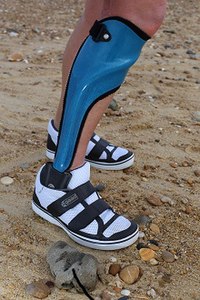
Photo from wikipedia
Objective Ankle osteoarthritis (AO) is a usual long-term complication of ankle trauma. Pain during walking is the main symptom limiting walking distance. Non-surgical treatment including drugs, corticosteroid intra-articular injection or… Click to show full abstract
Objective Ankle osteoarthritis (AO) is a usual long-term complication of ankle trauma. Pain during walking is the main symptom limiting walking distance. Non-surgical treatment including drugs, corticosteroid intra-articular injection or orthosis, could be used to decrease pain. The gold standard treatment of end stage of AO is the definitive surgical ankle arthrodesis. The purpose of this study is to prove the effectiveness of the hind foot stabilisation orthosis called “arthrodesis simulation” (AS) on the walking-pain and walking distance in a population suffering from ankle and/or hind foot osteoarthritis. Material/patients and methods A single case experimental design (SCED) with a structure (A1-B1-A2-B2) used randomly repeated measurements of a 2 MWT to determine changes at each phase of the study. Pain at the end of the 2 MWT using a visual analogue scale and the walking distance were evaluated by a blind assessor. One patient from Regional Rehabilitation Institute in Nancy (IRR, France) suffering from AO and wearing an AS daily, walked at fast speed during the 2MWT without AS during the 2 baseline phases (A1, A2) and with AS during the 2 intervention phases (B1, B2). Visual analysis, mean, trend and nonoverlap of all pairs (NAP) were calculated for both values for each phase. Results The average pain was significantly different between each phase (A1-B1-A2-B2) (Wilcoxon test). The pain NAP was 100% which corresponds to all data points assessing pain were greater during walking without AS. The pain trend increased with the measurement time without AS whereas the pain trend was stable, close to 0, with AS. The average walking distance was significantly different between each phase (A1-B1-A2-B2) (t-test). The walking distance NAP was close to 100% corresponding to all data points assessing walking distance were greater with AS. The walking distance trend increased faster with AS compared to without AS. Discussion, conclusion This SCED demonstrated the effectiveness of the AS on walking-pain and walking distance in people suffering from AO. Wearing AS increased walking distance during 2MWT without pain. Further SCEDs are necessary to confirm AS efficiency. This device, which is an orthopaedic treatment, could be an interesting alternative to surgical ankle arthrodesis.
Journal Title: Annals of Physical and Rehabilitation Medicine
Year Published: 2017
Link to full text (if available)
Share on Social Media: Sign Up to like & get
recommendations!